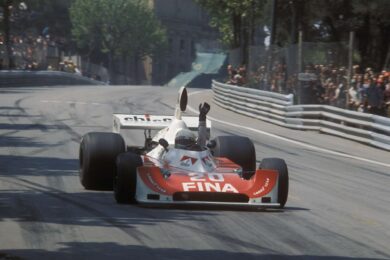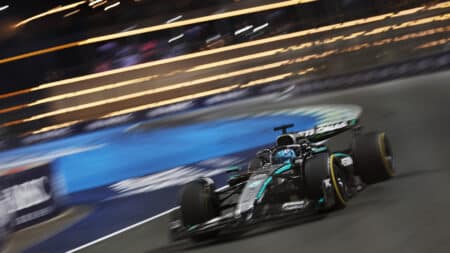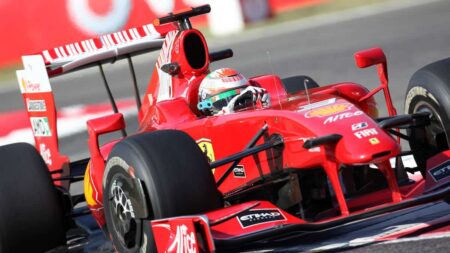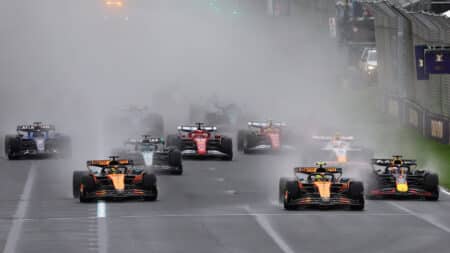
Paradise lost: Montjuïc and the 1975 Spanish Grand Prix
Try to imagine your ideal street track, and the only limits are your imagination. It would be fast and challenging; a touch daunting. It would have sharp gradient changes –…
They’d said it would be over by Christmas.
Yet by 1915 the vast Vickers ‘shed’, built in response to the spiralling mechanised demands of an already entrenched conflict, loomed over the Fork at Brooklands.
The Royal Flying Corps had taken control of the Surrey speedbowl the day after war broke out and Lieutenant Colonel Charles Jarrott, Britain’s foremost racing driver of the Victorian/Edwardian age, winner of the 1902 Circuit des Ardennes, was to be its Inspector of Transport.
The younger John Moore-Brabazon, the Ardennes winner of 1907, was also with the RFC. His role in the creation and advancement of stereoscopic aerial photography earned him a Military Cross and promotion to Lieutenant Colonel.

Kenelm Lee Guinness in the 1924 French Grand Prix
Not every racing driver was attracted to the newest and fastest armed service. Kenelm Lee Guinness, winner of the 1913 Tourist Trophy for Sunbeam, joined the Royal Navy. Such was the importance to the war effort of his KLG spark plug company, however, he was asked to resign his commission.
Future team-mate and fellow Land Speed Record holder Henry Segrave, an Eton-educated Sandhurst graduate, became an 18-year-old Second Lieutenant with the Royal Warwickshire Regiment in January 1915. He survived March’s offensive on Neuve Chapelle – more than 11,000 Allies didn’t – but two months later was shot at point-blank range in his left shoulder.
Upon his return to fitness, he was transferred to the RFC Central Flying School at Upavon in Wiltshire and received his ‘wings’ on New Year’s Day, 1916.
Initially frustrated by his role of ferry pilot, his maiden combat patrol was on April 21 and he scored his first kill – an Aviatik two-seater – on May 1.

It remained his only kill.
His brand new F.E.8 scout single-seater crippled by anti-aircraft fire, he crashed on landing in early July and suffered a complex fracture of the left ankle. Captain Segrave would ‘fly a desk’ for the remainder of hostilities.
Among a number of men seeking to replace the rush of war in peacetime, he was by 1920 racing a Grand Prix Opel at a reopened Brooklands.
There, he met fellow RFC ferry pilot Captain Malcolm Campbell, who had raced before the war.
Others soon followed, among them Captain George Eyston and Major (the youngest in the British Army) Goldie Gardner, both ex-Royal Artillery and recipients of the Military Cross.
Only the ‘Bentley Boys’ would equal the fame of these inveterate and successful racers and record-breakers. And each also had wartime tales to tell.
Captain Woolf Barnato saw action with the Royal Artillery in France, Egypt and Palestine.

Bentley Boys Clement, Birkin and Barnato in 1928
Captain Dudley Benjafield also served in Egypt, as a doctor with the Royal Army Medical Corps.
Captain Henry Birkin was with the RFC in Palestine when he contracted malaria.
Captain Clive Gallop was for a few days in 1917 the Commanding Officer of the elite 56 Squadron.
Sammy Davis was invalided out of the Royal Naval Air Service after serving in armoured cars in France.
Captain John Duff, a Canadian who travelled across Russia from China to enlist with the Royal Berkshires, was wounded by friendly fire at Ypres in 1917, having advanced too far, too quickly for the creeping barrage supposed to shield him.
Lieutenant Commander Glen Kidston was torpedoed twice in the North Sea – on the same day! On 22 September 1914 German submarine U-9 sank three Royal Navy cruisers and Kidston was aboard two of them: HMS Aboukir and HMS Hogue.
And Australian-born Bernard Rubin was so badly wounded while with the Royal Garrison Artillery that he underwent three years of rehabilitation.

Barnato and Rubin after winning Le Mans in 1928
Motor racing’s most remarkable WWI involvements, however, were those of an American – and a woman.
Eddie Rickenbacher was born in 1890 to Swiss-German immigrants in Columbus, Ohio.
A precocious mechanic, he was Lee Frayer’s passenger in the Elimination Trial for the 1906 Vanderbilt Cup.
Having taken the wheel himself by 1910, he became famous as much for his cocksure personality and fearlessness as his results.
Ranked third in 1916 by the American Automobile Association, he sailed to Europe in December to locate, purchase and export a suitable racing car – only to be arrested on his arrival in Liverpool and strip-searched and interrogated as a suspected spy.
He had already Americanised his surname to Rickenbacker, but British Intelligence had swallowed whole the concocted promotional guff that he was Baron von Rickenbacher, a Prussian recently escaped from Vienna in a stolen Mercedes so desperate was he to race in America.

Eddie Rickenbacker (centre) with the Borg Warner Trophy. Photo: IMS
Released after an intervention by Sunbeam’s Louis Coatalen, Rickenbacker returned home empty-handed but with a burning desire fired by a sneak visit to Brooklands. Determined to play a part in the war sooner rather than later, he attempted to persuade his government to create an air squadron comprised of racing drivers and their mechanics.
Not only was this idea swatted aside but also he was told that he was too old, at 27, to be a fighter pilot.
So he enlisted with the American Expeditionary Forces as a Sergeant, First Class and impressed several top brass in France with his driving skill, engineering prowess and unswerving desire to fly.
He got his way in 1918 and joined the famous 94th‘Hat in the Ring’ Squadron of the formative United States Air Service. When eventually its planes – nimble but delicate French Nieuports to begin with and then superior SPADs – and finally their machine guns arrived, Rickenbacker got busy.
He registered his first aerial victory at April’s end, and scored five more in May.
Grounded by an ear infection, he returned in September and in the space of six weeks shot down 20, including 13 Fokker D.VIIs – reckoned to be Germany’s best aircraft – and four observation balloons.
Despite his humble background and a badly damaged eye – a holed cornea that he kept secret from his superiors – ‘Captain Eddie’ had become America’s ‘Ace of Aces’.

Rickenbacker aboard his SPAD
Lasting fame assured, his ownership of Indianapolis Motor Speedway from 1928-45 was just one part of a storied life thereafter.
Muriel Thompson is less well known.
From a wealthy Scottish shipping family, she was an early mover in the Brooklands Automobile Racing Club alongside younger brother Oscar.
In 1908, driving Oscar’s modified Austin, nicknamed Pobble, she won the three-mile Ladies’ Bracelet Handicap, the first such race at Brooklands. Later that year she beat the Arrol-Johnston of Christabel Ellis in a match race and defeated all-comers in a blindfolded driving contest.
In 1909, she was a chauffeur to suffragette leader Emmeline Pankhurst on her national tour.
Her offer to supply and drive an ambulance on the Western Front having been rejected in 1914 on account of her ‘unsuitable’ gender, she joined the First Aid Nursing Yeomanry in 1915 – as an ambulance driver.
Attitudes were changing out of necessity.
Her bravery under fire was recognised that year by King Albert I of Belgium, who personally presented a Knight’s Cross of the Order of Leopold II.
She also won the Military Medal and Croix de Guerre (with Palm Leaf) when in May 1918 she and those under her command attended wounded throughout a bombing raid on a nearby ammunitions dump.
Motor racing was small beer in comparison.
Modern Formula 1, take note.

Try to imagine your ideal street track, and the only limits are your imagination. It would be fast and challenging; a touch daunting. It would have sharp gradient changes –…

Fears that one engine manufacturer will dominate F1 from 2026 are likely to see strugglers allowed to catch up. If power units are to be artificially equalised, how much of a technical competition will it be? asks Mark Hughes

For an Italian F1 driver, few roles are more coveted than a Ferrari race seat, but Giancarlo Fisichella had the misfortune of joining the team during a testing 2009 season

F1 moves closer to changing its rules in a bid to avoid one engine manufacturer dominating for years, and looks to spark out the grass fires that plagued Suzuka